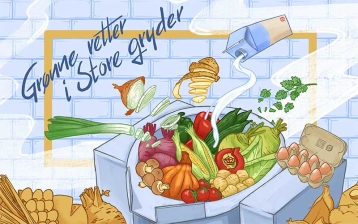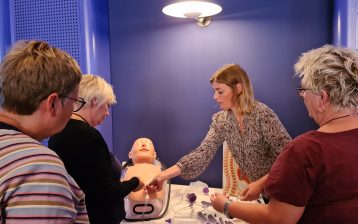
Why green dishes in large pots?
‘Green dishes in large pots’ rise from an ambition for cooking that supports the UN’s world goals. An important and necessary step in achieving these goals is to reduce the use of animal products in our kitchens. The production of these products affects the climate far more than the production of vegetable products.
With ‘Green dishes in large pots’, we want to make it possible for commercial kitchens all over Denmark to offer more green dishes to those they cook for. Our website includes more than 100 recipes for everything from bread, open sandwiches, soups, salts, fast food, appetizers, stews and desserts. These recipes are available for free, for all public kitchens and others who may be interested.
“Bispebjerg hospital has implemented the recipes and concept in their daily menu”
Nutrient content and sustainability
Food and meals prepared in public kitchens must live up to the Recommendations for the “Danish institutional diet”. In Green dishes in large pots, the ambition is furthermore, that the food must live up to the UN’s world goals, including especially goal 12: “Responsible consumption and production”. Specifically, this means that there is no meat in the dishes, as meat is generally far more climate-damaging than vegetables. In the development of the green recipes, meat has therefore been replaced by vegetables and legumes. The dishes include dairy products and eggs to ensure a balanced taste and nutrient composition. All dishes in “Green dishes in large pots” are calculated in energy per. 100 grams, and an energy percentage distribution (E%) has also been made for the individual dishes. This makes it quick, easy and safe to use the recipes in relation to the recommendations.
The individual green dishes should be seen as elements in a total daily diet over a period of time. They must therefore not be assessed alone but always in connection with the other meals of the day.
Protein content is calculated for the individual dish based on the fact that lunch and dinner should contain a minimum of 15-19 grams of protein. This is suitable for a 7-9 Mj diet targeted people with less appetite, where the three main meals together make up approx. 50% of today’s energy needs incl. need for vitamin B12. In-between meals and oral nutritional supplements ensure sufficient total daily intake.
Variation ensures a broad amino acid composition
When a kitchen starts replacing meat dishes with green alternatives, it is a good idea to vary their repertoire of green dishes. In this way, the amino acid profile becomes as complete as possible and all the nutrient recommendations are followed. When new and perhaps more unknown ingredients are used in cooking, it is a good idea to do so on a professional, calculated and tested foundation. That is why we have developed a replacement tool as an aid to kitchens that want to start cooking green dishes in large pots.
Implementation
One hospital (Bispebjerg) and Odense Municipality, who are the founders, have both already implemented the recipes and concept in their daily menu. There are yet no exact numbers of how many others are using the recipes, however, the website visits are increasing every day. Unfortunately, the recipes are not yet translated into English
By Gitte Breum, Food and Volunteering, Odense, Denmark and Mette Holst

Website
100 recipes for everything from bread, open sandwiches, soups, salts, fast food, appetizers, stews and desserts.
Visit website
Head of Clinical Nutrition Research, Aalborg University Hospital, editor for this homepage and spokesperson for the collaboration between DSKE, ONCA-Denmark and ONCA.




